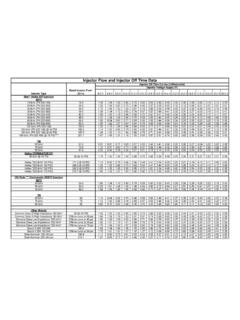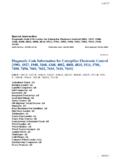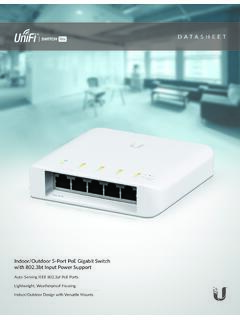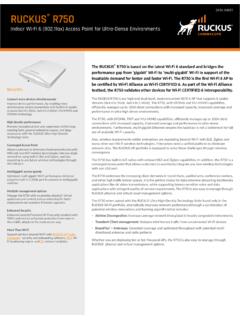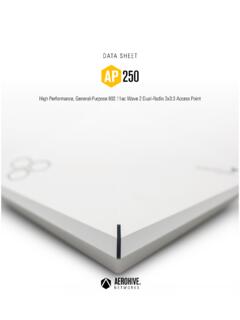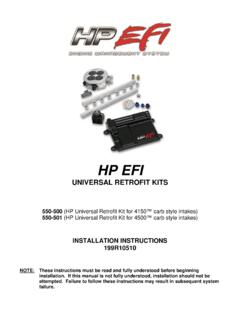Transcription of SpaceX Falcon 9 Data Sheet - NASA
1 Space Launch Report: SpaceX Falcon 9 data SheetHome On the Pad Space Logs Library LinksSpaceX Falcon 9 Updated May 01, 2017 Vehicle ConfigurationsVehicle ComponentsFalcon 9 ( ) Flight HistoryFalcon 9 data Sheet (New April 29, 2013)Dot-com multimillionaire Elon Musk established SpaceX Corporation in June 2002 in an ElSegundo, California warehouse, intent on developing the small " Falcon " launch vehicle and trocket engines to power it. By early 2003, the company was testing early prototypes of its 40tonne-thrust-class Merlin first stage engine and tonne thrust Kestrel second stage engineMcGregor, Texas test site.
2 Merlin was a gas generator cycle engine that used a pintle style injector, an injector design adfrom the Apollo Lunar Module engine. Turbopump exhaust provided roll control. The enghad an ablatively cooled thrust chamber and nozzle. Kestrel, which also used a pintle injector, was a pressure fed design. Kestrel had a radiatively cooled Niobium nozzle and an ablatively cooled chamber and throat. Enter Falcon 5On December 3, 2003 in Washington , during its Falcon "protovehicle" unveiling ceremonies, Elon Muskannounced that SpaceX planned to follow-up Falcon (thereafter called " Falcon 1") with a more powerful meterdiameter launch vehicle named " Falcon 5" that would be capable of hauling tonnes to low earth orbit (LEO) tonnes to geosynchronous transfer orbit (GTO).
3 Falcon 5 launches would be priced at $12 5 would stand about 29 meters tall and weigh about 130 tonnes at liftoff. Its first stage would be powered bMerlin engines producing a total of tonnes of thrust at liftoff and 192 tonnes in vacuum. Two upgraded Keengines would boost the second stage, producing nearly tonnes of total thrust. Like Falcon 1, Falcon 5 would u"pressure assisted stabilized" graduated monocoque friction stir-welded aluminum design with a common bulkheadbetween its aft kerosene tank and its forward liquid oxygen tank.
4 Both stages would be helium pressurized and woudesigned to be recovered at sea after floating down beneath parachutes. SpaceX hoped to recover parts of the stagreuse. Musk also described a concept for a follow-on Falcon 5 equipped with more powerful Merlin engines, producing 22tonnes of liftoff thrust. This Falcon 5 would be fitted with a liquid hydrogen second stage powered by one or more RL10 engines. It would be able to lift about 9 tonnes to tonnes to the ceremony, Elon described goals that seem hopelessly optimistic in retrospect.
5 He expected to fly the first Falcon 5 in November 2005 and to launch six Falcon 1 and four Falcon 5 missions per year by 2010 from still-to-be-developed launch sites at Cape Canaveral, Vandenberg, and Omelek Island at Kwajalein Atoll in the Marshall realities intervened during 2004, when SpaceX struggled with Merlin development. Cast aluminum manifolds cracked during tests, requiring replacement with heaviinconel manifolds. The engines were not quite as efficient as planned, requiring thrust to be increased to offset the lower specific impulse.
6 Merlin had to be redesigned and retesteprocess that extended through the year. By late 2004, SpaceX listed a launch schedule that included a Falcon 5 launch of a test payload for Bigelow Aerospace. By then the Falcon 5 design had been beefed up to haul 6 tto LEO. Higher thrust "Merlin 1B" engines were now assigned to power the first stage, producing nearly 193 tonnes of liftoff thrust, and a single Merlin replaced the Kestrel pair the second stage. The second stage Merlin would use a large nozzle extension to increase specific impulse to as high as 340 seconds in vacuum.
7 This was a Delta II category launcvehicle design. Falcon 9 AnnouncedDuring 2005, SpaceX began Falcon 5 fabrication and development. Plans called for 12 Merlin 1B enginbe completed during the year, but in September 2005, the plans changed. SpaceX announced that it wodevelop " Falcon 9", powered by nine Merlin 1B first stage engines, to meet the needs of an unnamedgovernment customer. Falcon 9 would be able to boost more than 9 tonnes to LEO or more than 3 toto geosynchronous transfer orbit (GTO) for $27 million.
8 Even more powerful versions, with parallel Fbooster strap-ons, were projected for the future. Falcon 9S5 would use two Falcon 5 strap-on boostersFalcon 9S9 would use two Falcon 9 strap-on boosters. No longer a Delta II class launch vehicle, Falconentered the EELV payload Falcon 5 design was changed yet again, becoming a partially loaded Falcon 9 stripped down to onlyMerlin first stage engines. The change meant that Falcon 5's LEO payload fell to 4 tonnes while its pricto $18 first Falcon 1 launch campaign at Omelek extended through the final months of 2005 into the early months of 2006, culminating with an inaugural flighfailure on March 24, 2006.
9 SpaceX spent much of 2006 evaluating, and recovering from, the failure. Dragon, NASA COTS, and Merlin 1 CIn September, 2006, SpaceX won one of two NASA Commercial Orbital Transportation Services contracts. The $278 million award was for three flightdemonstrations by SpaceX of its to-be-developed 7 tonne "Dragon" spacecraft on Falcon 9 launch vehicles. The launches, planned at the time to begin in l2008, would demonstrate Dragon's ability to haul tonnes of cargo to the International Space Station (ISS) and to return cargo to 2006, Elon Musk also announced that SpaceX had decided to begin work on a "Merlin 1C" engine with a regeneratively cooled thrust chamber.
10 In early February 2007, Spupdated its web site with revised design information for both Merlin and Falcon . The data was said to be effective for vehicles launched in 2009 or later. Merlin 1C was shown toproduce tonnes of sea-level thrust - a 32% increase over the thrust produced by Merlin during the initial Falcon 1 launches. Falcon 9 was shown using nine Merlin 1C engiproviding a 20% thrust increase over the previously announced Merlin 1B engines. By the time a revised Payload User's Guide was published in May 2007, Falcon 5 had disappeared from the company's catalog altogether.

